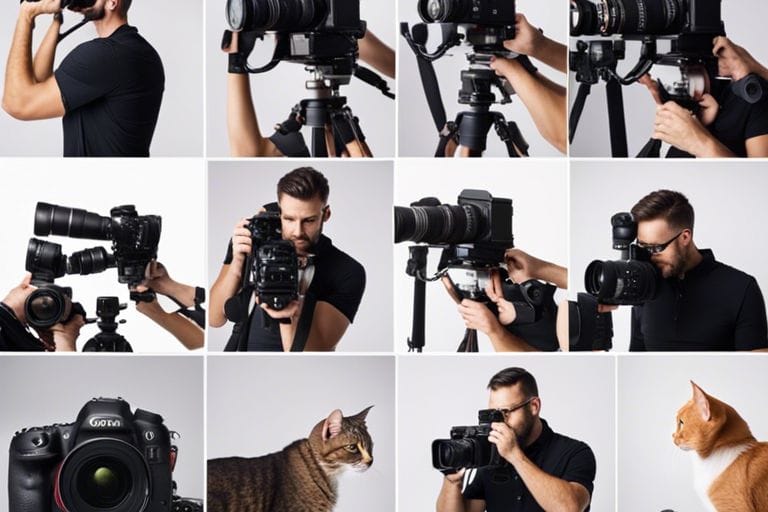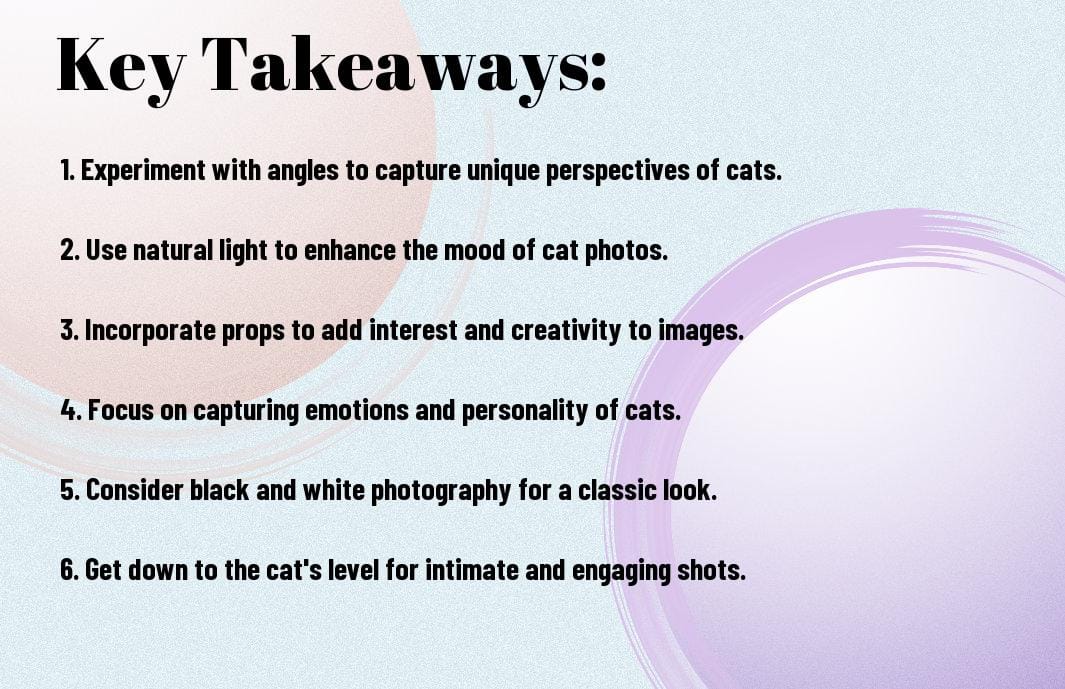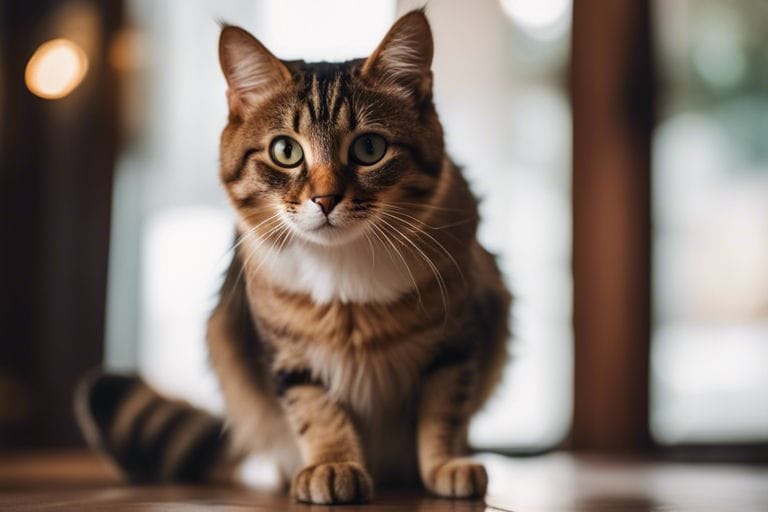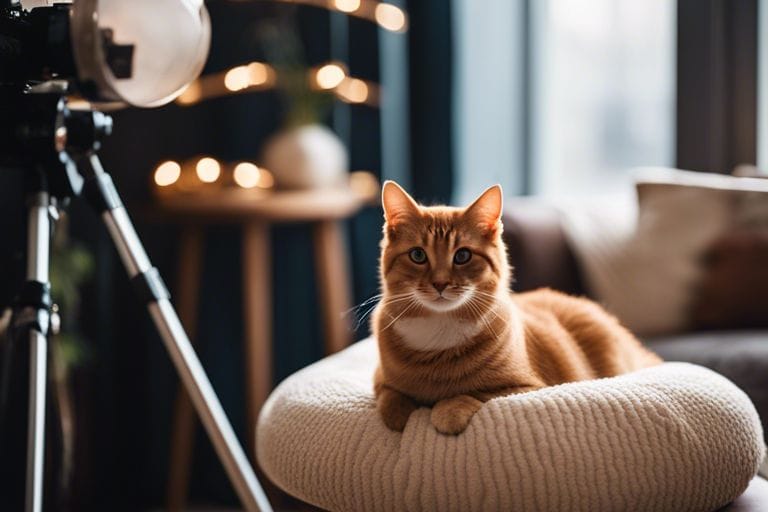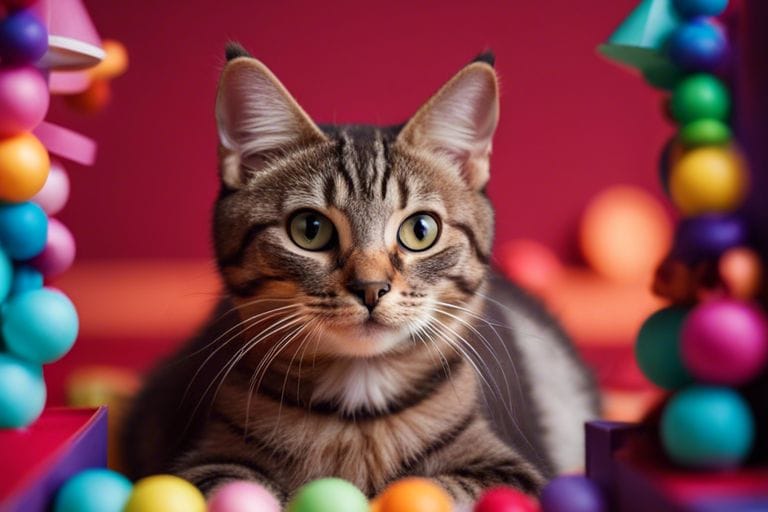With cats being one of the most popular subjects in the world of pet photography, capturing stunning close-up portraits of these furry felines can be a rewarding and enjoyable experience. To achieve captivating images that showcase your cat’s unique personality and features, there are several key tips to keep in mind. Whether you are a seasoned photographer looking to enhance your cat photography skills or a beginner looking to capture professional-looking shots, these tips will help you elevate your close-up cat portraits to the next level.
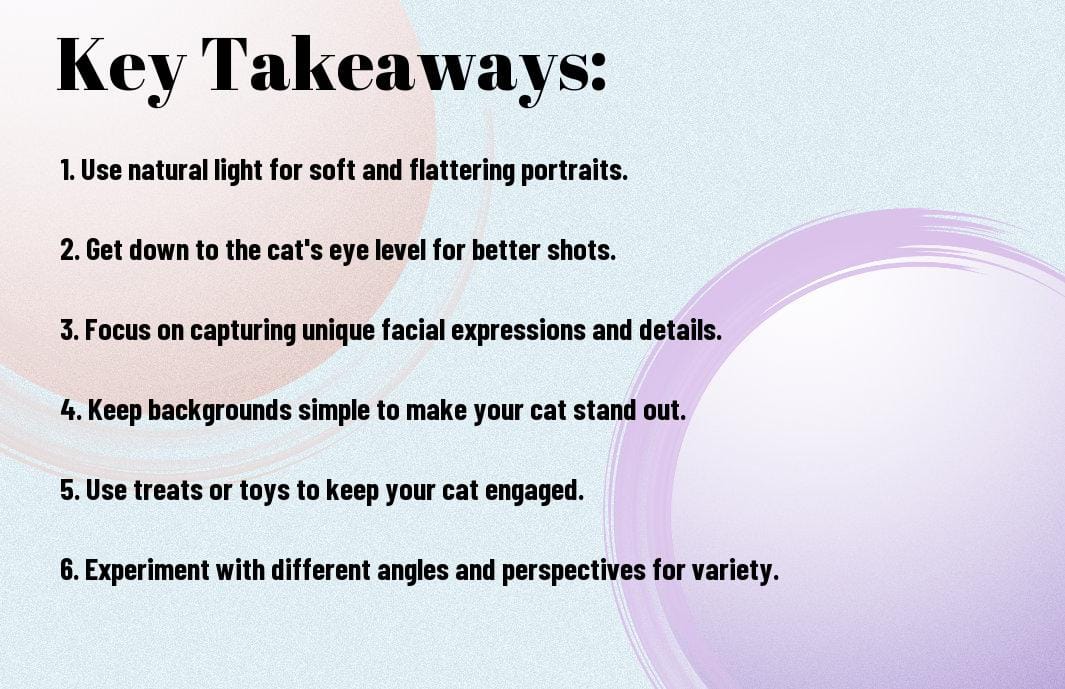

Essential Gear for Close-up Photography
Choosing the Right Camera
One of the most important pieces of gear for close-up cat photography is the camera itself. When choosing a camera for close-up shots, opt for a DSLR or mirrorless camera that offers manual controls for settings like aperture, shutter speed, and ISO. These settings will give you the flexibility needed to capture stunning close-up portraits of your feline friend.
Lenses for Close-Up Shots
On your quest for the perfect close-up cat portrait, the lens you choose will play a crucial role. A macro lens is ideal for capturing intricate details and whiskers up close. With a narrow depth of field, you can achieve that beautiful blurred background, keeping the focus on your cat’s eyes and face.
Choosing the right lens for close-up photography depends on the type of shot you want to capture. A prime lens with a wide aperture, such as f/1.8 or f/2.8, can create stunning bokeh effects, adding depth and dimension to your images.
Additional Gear: Lights, Reflectors, and Tripods
One necessary piece of additional gear for close-up cat photography is lighting. Properly lighting your subject can make a world of difference in the quality of your images. Consider investing in a ring light or softbox to create soft, even lighting that enhances your cat’s features.
Camera tripods are also a must-have for close-up photography, as they help stabilize your camera and ensure sharp, focused images. Reflectors can be used to bounce light onto your subject, eliminating harsh shadows and creating a more flattering look.
Preparing for the Photoshoot
Creating a Comfortable Environment
Creating a comfortable environment is crucial when preparing to capture stunning close-up cat portraits. Cats are highly sensitive animals, so ensuring they feel safe and at ease will greatly improve the quality of your photos. Before starting the photoshoot, make sure the room is quiet and free of any distractions that could startle the cat. Place their favorite toys or blankets nearby to help them feel more relaxed.
Patience is Key: Waiting for the Right Moment
An necessary aspect of capturing captivating close-up cat portraits is to have patience and wait for the right moment. Cats are known for their independent and sometimes unpredictable nature, so it’s important to be prepared to spend some time waiting for them to be in the perfect position or to exhibit a specific expression that you want to capture.
With
The key to taking stunning close-up cat portraits is to be prepared to wait for the ideal moment when your cat is in a comfortable and relaxed state. This requires patience and a keen eye for detail to capture the unique expressions and personality of your feline friend.
Technical Aspects of Close-up Photography
Now, when it comes to capturing stunning close-up cat portraits, understanding the technical aspects of photography is crucial. This includes mastering the concepts of shutter speed, aperture, and ISO to achieve the best results.
Understanding Shutter Speed, Aperture, and ISO
On the technical side, shutter speed, aperture, and ISO are the three pillars of photography that directly impact the final outcome of your close-up cat portraits. Shutter speed controls the duration of light entering the camera, aperture regulates the depth of field and amount of light, while ISO determines the camera’s sensitivity to light. By balancing these settings effectively, you can achieve sharp, well-exposed images with beautiful bokeh that truly showcase your feline subject.
Focusing Techniques for Sharp Portraits
Photography enthusiasts often struggle with achieving sharp focus in close-up portraits. To overcome this challenge, it is imperative to understand and master different focusing techniques. These include using single-point focus to hone in on specific details of your cat’s features, utilizing back-button focus for quick adjustments, and employing manual focus for complete control over the sharpness of your image.
Techniques such as focus stacking can also be beneficial when shooting close-up portraits of cats, especially when trying to capture intricate details like whiskers or fur texture. By combining multiple images with slightly different focal points, you can create a final portrait with exceptional depth and sharpness, ensuring every whisker is perfectly in focus.
Composition and Framing
The Rule of Thirds in Cat Photography
Photography is an art form that relies heavily on composition, and one of the fundamental principles to keep in mind is the rule of thirds. When applying this rule to cat photography, imagine breaking your image into nine equal parts using two horizontal and two vertical lines. Placing your feline subject off-center, along one of these lines or at one of the intersections, can create a more visually interesting and balanced composition.
By following the rule of thirds, you can draw the viewer’s eye to your cat and create a dynamic and engaging portrait that captures their unique personality and charm.
Using Backgrounds to Your Advantage
On top of framing your cat in the perfect position, it’s necessary to pay attention to the background in your portraits. A cluttered or distracting background can take away from the beauty of your cat and the overall composition of your photo. Look for simple, unobtrusive backgrounds that complement your cat’s fur color or eye color to enhance the aesthetic appeal of your portraits.
Understanding how to use backgrounds effectively can elevate your photos and make your cat the star of the show. Experiment with different backgrounds such as textured walls, lush greenery, or soft blankets to find what works best for your feline friend and creates stunning close-up portraits.
Lighting and its Impact
After composition, lighting is one of the most crucial elements in capturing stunning close-up cat portraits. The way light falls on your feline subject can make or break the final image. Understanding the different types of lighting and how they affect your photos can elevate your photography skills to the next level.
Natural Light vs. Artificial Light
An important consideration when taking close-up cat portraits is whether to use natural or artificial light. Natural light, such as sunlight streaming through a window, can create a soft and flattering glow on your cat’s fur. It can also bring out the natural colors and textures of your cat’s coat, making for a more organic and captivating photo. On the other hand, artificial light sources like studio lights or flash can be used to control and manipulate the lighting conditions, providing consistency and precision in your portraits.
Soft Lighting for Flattering Portraits
To achieve soft and flattering lighting in your close-up cat portraits, consider using diffused light sources. Soft lighting helps minimize harsh shadows and highlights, resulting in a more even and gentle illumination on your cat’s features. This type of lighting is ideal for capturing the intricate details of your cat’s fur, whiskers, and eyes without overwhelming the photo with distracting contrasts.
With soft lighting, you can create a warm and inviting atmosphere in your cat portraits, enhancing the overall mood and aesthetic appeal of the image. Experiment with different light modifiers such as softboxes, umbrellas, or even sheer curtains to achieve the desired softness and quality of light in your photos.

Capturing the Cat’s Personality
Encouraging Natural Behavior
Many photographers find that the best way to capture a cat’s true personality in a photograph is to encourage natural behavior. Cats are unpredictable creatures, so it’s imperative to create a comfortable environment where they can be themselves. Make sure the cat is relaxed and at ease before attempting to take any photos.
Tips for Catching Expressive Moments
The key to getting stunning close-up cat portraits is to catch those expressive moments that truly showcase their unique personality. One tip is to have your camera ready at all times and be patient. Cats have a way of surprising us with their quirky behaviors, so it’s important to be prepared to capture those moments as they happen.
- Focus on the eyes to capture the depth of emotion
- Use natural light to enhance the mood of the photo
Behavior plays a crucial role in capturing expressive moments of your cat. By observing their body language and movements, you can anticipate when they are about to do something interesting or adorable. This proactive approach can significantly increase your chances of getting that perfect shot that truly represents your cat’s personality.
- Patience is key when waiting for the right moment to press the shutter button
Post-Processing Techniques
Basic Photo Editing for Enhancing Your Shots
Despite capturing a fantastic close-up cat portrait, there’s always room for improvement through post-processing. Techniques such as adjusting exposure, contrast, and white balance can elevate the overall quality of your image. Basic editing tools like cropping, straightening, and sharpening can help enhance the composition and clarity of your cat portraits.
Retouching Tips for Perfecting Fur and Eyes
Enhancing your cat portraits involves paying attention to details like fur texture and eye clarity. Retouching tools can be utilized to remove distractions, spot correct imperfections, and bring out the fine details in the fur and eyes of your feline subject. Adjusting brightness and saturation of the eyes can give them a mesmerizing allure, while refining fur texture can make your cat portraits truly captivating.
- The key to retouching fur and eyes is to maintain a natural look while enhancing the details.
Post-processing plays a crucial role in creating stunning close-up cat portraits that stand out. Utilizing various editing techniques and retouching tips can help you achieve the perfect balance between enhancing your images and preserving the essence of your feline subject. Note, practice makes perfect, so don’t be afraid to experiment and refine your post-processing skills to showcase the beauty of your beloved cat companions.
Advanced Techniques and Creative Ideas
- High-Speed Photography for Action Shots
To capture dynamic and playful moments of your furry feline, high-speed photography is vital. This technique allows you to freeze fast movements and fleeting expressions with precision, resulting in stunning action shots. To achieve this, set your camera to a high shutter speed of at least 1/1000th of a second and use continuous shooting mode to capture a series of rapid-fire images.
Moreover, consider using artificial lighting or natural light sources to ensure your photos are well-lit and sharp. Experiment with different angles and perspectives to add depth and drama to your action shots, showcasing the energy and personality of your cat in a single frame.
- Incorporating Props and Costumes
An innovative way to add a touch of whimsy and individuality to your close-up cat portraits is by incorporating props and costumes. This creative approach allows you to showcase your cat’s unique personality and create visually captivating images that stand out from traditional portraits. Whether it’s a cute hat, a colorful scarf, or a playful toy, props and costumes can add a fun and personalized touch to your photos.
Incorporating Props and Costumes
This creative approach allows you to showcase your cat’s unique personality and create visually captivating images that stand out from traditional portraits. Whether it’s a cute hat, a colorful scarf, or a playful toy, props and costumes can add a fun and personalized touch to your photos.
This technique also provides an opportunity to incorporate thematic elements that reflect your cat’s favorite activities or interests. From seasonal props like pumpkins for autumn or holiday-themed costumes, the possibilities are endless. Experiment with different props and costumes to create a whimsical and memorable close-up cat portrait that captures the essence of your feline companion.
Summing up
With this in mind, mastering the art of taking stunning close-up cat portraits requires a combination of patience, practice, and the right techniques. By focusing on capturing the unique characteristics and expressions of your feline friend, using natural light to your advantage, and experimenting with angles and compositions, you can create beautiful and captivating images that truly showcase the personality of your cat. Remember to stay calm and be gentle with your pet to ensure a successful photoshoot.
FAQ
Q: Why are close-up cat portraits popular among pet owners?
A: Close-up cat portraits capture the unique features and expressions of a cat up close, allowing pet owners to showcase the personality and charm of their feline companions.
Q: What equipment is vital for taking stunning close-up cat portraits?
A: Essential equipment for close-up cat portraits includes a camera with a macro lens for capturing intricate details, a fast shutter speed to freeze motion, and good lighting to illuminate the cat’s features.
Q: How can I ensure my cat stays calm during a close-up photoshoot?
A: To help keep your cat calm during a close-up photoshoot, choose a quiet and familiar environment, use treats or toys to hold their attention, and take breaks if your cat becomes agitated.
Q: What are some composition tips for capturing striking close-up cat portraits?
A: When composing close-up cat portraits, focus on the cat’s eyes as they are the most expressive feature, experiment with different angles to find the most flattering shot, and consider using a shallow depth of field to create a dreamy background blur.
Q: How can I edit close-up cat portraits to enhance their beauty?
A: When editing close-up cat portraits, consider adjusting the brightness and contrast to highlight details, sharpening the image to enhance clarity, and applying a soft focus effect to create a more artistic look.
